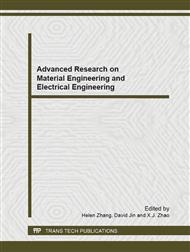p.3
p.8
p.13
p.17
p.22
p.27
p.31
p.35
Low Resistivity Aluminium Alloy of High Tensile Strength and Elongation
Abstract:
Through testing the mechanical properties and electrical property, the conductive aluminum alloy with high strength and elongation was obtained by adjusting the content of Fe, B and misch metal elements constantly, and the influence mechanism of the add elements was discussed by observing microstructure morphology of the aluminum alloy. The results indicated that the addition of Fe could effectively improve the tensile strength of commercial aluminum, while the addition of misch metal could change the existence form of Fe, thus to compensating for the decrease of elongation because of the addition of Fe. On the other hand, the addition of appropriate B could remove the harmful impurity elements of the aluminum alloy and refining the grain, so as to reduce the resistivity of the aluminum alloy with adding iron and rare earth elements. Finally, the optimum was obtained which was the composition of 99.18%Al-0.75%Fe-0.05%Re-0.02%B, the tensile strength was 103MPa, the elongation was 30.98% and the resistivity was 2.737×10-8Ω•m.
Info:
Periodical:
Pages:
3-7
Citation:
Online since:
March 2013
Authors:
Keywords:
Price:
Сopyright:
© 2013 Trans Tech Publications Ltd. All Rights Reserved
Share:
Citation:


